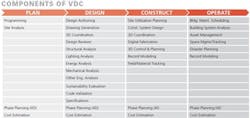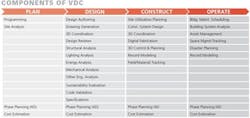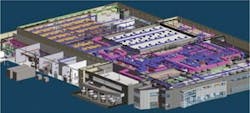Virtual Design & Construction Bring All Parties Together
It is both exciting and challenging to live through leaps in technology. Current generations have seen the leap from typewriters to word processors, from wired analog telephones to wireless smartphones, from blueprints on a drafting table to Computer Aided Design (CAD) drawings. Today, the building and construction professions are moving from 2D building plans as the standard to 3D building models, or 3D/BIM, which incorporates Building Information Modeling (BIM). In addition to 3D/BIM, technology is now expanding to Virtual Design and Construction (VDC), a complete modern design plan and delivery method, in which 3D/BIM is one of several elements. VDC is exceptional in its ability to integrate the team, the technology, and a total project delivery strategy.
AN OVERVIEW OF VDC
The integration of the design and construction team provides an optimal of collaboration. While 3D/BIM provides its model, VDC uses tagging to encapsulate information about a project across the entire process of design, construction and use of a building. Thus, VDC facilitates collaboration between design, construction and client. VDC is a system wherein the modeling software is a tool, the BIM (model) is the product, and collaborative concurrent engineering and design is the process.
The phases of the VDC project delivery process are plan, design, construct and operate. All four phases incorporate phase planning and cost estimation. The process of VDC removes barriers to fully utilizing the informational capabilities of BIM and sharing that model with the construction team and end-user so that the same model can be used again.
The VDC method has four phases: Plan, Design, Construct and Operate. All four incorporate phase planning (4D) and cost estimation. The planning phase consists of programming and site analysis. The design phase covers a wide range of tasks, including design authoring, drawing generation, 3D coordination, design reviews, analysis of structure, electrical and mechanical needs, sustainability evaluation, code requirements and specification. During the construction phase, BIM is used for site utilization planning, construction system design, 3D coordination, digital fabrication, 3D control and planning, record modeling and material tracking.During operation, the model helps with building maintenance scheduling, system analysis, asset management, space tracking, disaster planning, and record modeling. At its core, BIM is a database where valuable information can be collected and related to the objects represented virtually in the model. In the hands of a team working collaboratively in the concurrent engineering process, the BIM can be developed and used in many valuable ways.Designers embed details about each element of each system within the VDC plan. They capture valuable parameters related to every component — whether it is a beam, a wall, a duct, a pipe or a cable tray — all within a finished digital building design. By itself, 3D/BIM certainly helps users make sound, informed decisions, but VDC reaches farther by tagging each piece for construction contractors, fabricators and other trades involved with the project. If a BIM lacks the collaborative element, it is difficult to make the important determinations, and the value of the BIM is diminished. With VDC, designers and others contribute to the model on an ongoing basis, providing enough information to make value determinations about important parameters, capturing valuable information early in the process for later benefit.
Such detail and intricacy can be decisive for designing complex and intensive infrastructure work, such as tight-fitting HVAC ductwork, where it would be impossible on 2D drawings to coordinate and represent every piece of duct work in a tight space. In contrast, BIM reveals space conflicts in virtual reality before any conflict actually shows up. Another win for VDC is faster and more accurate bid pricing because contractors and fabricators can determine down to the individual unit what a structure includes; for example, the number of feet of duct or cable, or the number of ceiling or floor tiles. Similarly, VDC, with its more precise information, reduces on-site mistakes which saves money and time for everyone.
A RICH TROVE OF DATA
The integration of the design and construction team allows a holistic view of the project from the standpoint of the owner’s business case while ensuring that the input of all the stakeholders is gathered and acted on early in the project. At the outset of a VDC method, a client can provide designers, fabricators and contractors with their own tagging scheme by which to identify both large and small pieces of equipment. Until now, this level of detail would be addressed only after the project is complete, requiring an owner to re-tag items for facility management or regulatory approval (such as FDA approval of pharmaceutical plants).
However, VDC can meet this owner-driven need at the very start of the project, so that value decisions about information parameters can be made before the modeling is complete, eliminating re-tagging time, trouble and cost at the conclusion of the project.
Throughout staging and construction, VDC enables all stakeholders (including fabricators and contractors) to update the building model by detailing and tagging any on-site construction changes for a complete virtual record of a project.
By the end of a VDC method-driven project, designers, fabricators and contractors can input every piece of equipment with number, definition and schedule. A finished project that uses the VDC method has the potential to contain a record of every installed item. Its 3D/BIM component displays the item vertically and horizontally in a 3D model. Building and validation inspectors, as well as facility managers, will all know where to locate every item without a lengthy search. The data in the model can be shared and accessed via a variety of database applications, allowing it to serve as a benchmark for future facility adaptation.
At its core, BIM is one of the elements of VDC, a database where valuable information can be collected and related to the objects represented virtually in the model. More than just another software package, VDC fully leverages the capabilities of a single 3D/BIM model through its lifecycle: from design through construction and occupancy/process approvals, all the way through facility use and updating.
When the finished structure is delivered, its owner and end-users become the beneficiaries, managers and caretakers of a rich collection of BIM data. Throughout the life and operation of the building, users can mine VDC information and add to its depth as the facility is maintained and conditions change. More than just another software package, VDC is a method that fully leverages the capabilities of a single 3D/BIM model through its lifecycle: from design through construction and occupancy/process approvals, all the way through facility use and updating.Consider a case where VDC is used in a facility that requires FDA approval on minute details such as shut-off valves that must be placed exactly where they were planned and are shown on a model. The owner does not know which valves the FDA will check in the post-construction approval process, so each one must be documented and verifiable. A 3D/BIM model with embedded records is vastly more accessible than 2D drawings for project stakeholders as well as inspectors, and so it is a more efficient delivery and storage method for essential information.
Another setting that demonstrates BIM/VDC’s value is in designing and managing industrial production spaces. The model can hold essential information about equipment such as storage bins and down-flow booths, including height, dispersion ingredients and locations, and distance to ceiling and walls. As the demands of the production process (and of the entire facility) evolve over time, the model’s embedded details provide future engineers with the necessary information and 3D images to design transformations from one phase of the facility’s functional life to another.
VDC AND VALIDATION
As with data management and modeling described above, integration is also a key VDC contribution to validation. After plant construction is complete, a pharmaceutical company has a year to prove to the FDA that it can manufacture the product in accordance with current good manufacturing (cGMP) practices. Validation protocols, such as filter replacement timing, can be incorporated into the VDC model. So, in addition to the parameters of the objects, the model can be utilized for a maintenance schedule.
In the pharmaceutical industry, validation is the process of establishing documentary evidence that provides a high degree of assurance that a specific process will consistently result in a product meeting its predetermined specifications and quality attributes. Every step, process and change must be properly evaluated before its implementation. Testing a sample of a final product is not considered sufficient evidence that every product within a batch meets the required specification.
Process validation is the collection and evaluation of data, from the process design stage through commercial production, which establishes scientific evidence that a process is capable of consistently delivering quality product.
Following process validation, installation qualification, operational qualification and performance qualification protocols provide a series of tests and results that support the conclusion that the equipment or systems meet the requirements defined in the Design, Functional and User Requirement Specification. A robust validation protocol contains an explanation of the validation approach and methodology, step-by-step test procedures, and clearly defined, pre-approved acceptance criteria that traces directly to the specification documents, as well as clearly recorded supporting data.
The VDC method brings time-saving benefits to this validation process. The validation technician uses the 3D/BIM model, which has previously identified all cGMP areas with processing equipment, and associated HVAC and utilities to record the checks and verifications for critical components. The owner receives the 3D/BIM model, which has as-built information for the entire facility and process equipment and utilities tagged with information from commissioning and validation efforts.
ELIMINATE THE BACKWARDS STEP
While 3D/BIM models are routinely improving the design process on many projects, the overall VDC method is not yet being used to its fullest extent in most construction projects. For example, many designers use the design benefits of 3D/BIM, but then (sometimes at the client’s request) they still output 2D drawings for construction, decreasing efficiency and increasing cost. This backwards step adversely affects both the visible elements, like equipment and furnishings, and the invisible ones, like a building’s mechanical and electrical infrastructure. In fact, many contractors and fabricators who recognize the benefits of 3D/BIM create their own models from the issued 2D drawings.
On the other hand, using VDC across a project offers a step forward. It reduces the inherent waste, time, cost and potential for error in 2D drawings, and it generates compressed schedules, a higher quality design, cost savings and an end result that is much more closely aligned with design intent.
The central power of VDC is its integration of the team, the technology, and a total project delivery strategy. The integration of the design and construction team, when combined with a project delivery approach, provides a higher amount of collaboration and allows a holistic view of the project from the standpoint of the owner’s business case while ensuring that the input of all the stakeholders is gathered and acted on early in the project.
As the design and construction professions move further into the 21st century, VDC will become the new normal as it enhances BIM. In the fields of design and construction, VDC will prove itself to be the watershed project delivery leap of this age.


